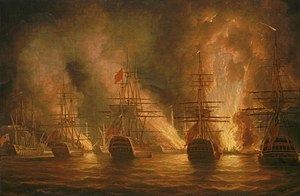Invasion of Trinidad (1797)
| Capture of Trinidad | |||||||||
|---|---|---|---|---|---|---|---|---|---|
| Part of the French Revolutionary Wars | |||||||||
 The Capture of Trinidad, 17 February 1797 by Nicholas Pocock |
|||||||||
|
|||||||||
| Belligerents | |||||||||
|
|
|
||||||||
| Commanders and leaders | |||||||||
|
|
|
||||||||
| Strength | |||||||||
| 10,000 soldiers & marines 18 ships: 9 ships of line, 3 frigates, 3 corvettes, 3 sloops |
2100 soldiers, seamen & marines (including ~700 sick) 4 ships of line 1 frigate |
||||||||
| Casualties and losses | |||||||||
| 1 killed | 2,100 captured (~700 sick) 4 ships scuttled 1 ship captured |
||||||||
British victory
On February 18, 1797, a fleet of 18 warships under the command of Sir Ralph Abercromby invaded and took the Island of Trinidad. Within a few days the last Spanish Governor, Don José María Chacón surrendered the island to Abercromby.
Spain, previously an ally of Great Britain, had been defeated in the War of the Pyrenees against France in 1795 and forced to sign the Peace of Basel. An alliance convention between France and Spain was signed the following year in 1796. British forces in the Caribbean in 1796 had already taken French colonies such as Saint Lucia and later Dutch colonies in South America; Demerara and Essequibo. With the Spanish now at war with Great Britain, the general Ralph Abercromby thought it was right to necessarily render Spain's colonies an immediate object of attack. His first target was the Spanish island of Trinidad which being close proximity to Tobago which had been captured early in the war. The island had been Spanish since the third voyage of Christopher Columbus in 1498 and since 1777 was a province of the Captaincy General of Venezuela.
On the 12th of February, an expedition, composed of four sail of the line, two sloops and a bomb-vessel, under the command of Rear-Admiral Henry Harvey, in Prince of Wales, having on board his ship Lieutenant-general Sir Ralph Abercromby, as the commanding officer of the troops to be employed, quit Port-Royal, Martinique. On the 14th the rear-admiral arrived at the port of rendezvous, the island of Carriacou, and was there joined by another sail of the line, the 74-gun third-rate (Invincible), two frigates, three sloops, and several transports, containing the troops destined for the attack.
...
Wikipedia
